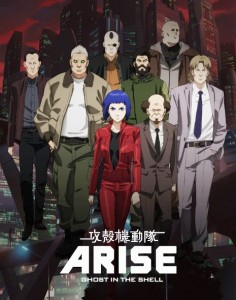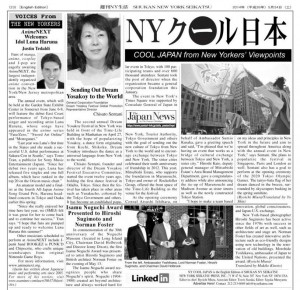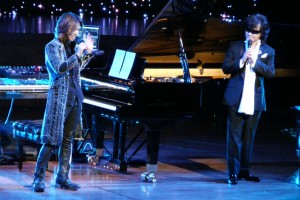Justin’s Japan: ‘Ghost in the Shell,’ Kishi Bashi, Luna Haruna at AnimeNEXT
By JQ magazine editor Justin Tedaldi (CIR Kobe-shi, 2001-02) for Examiner.com. Visit his Japanese culture page here for related stories.
After an unusually chilly spring, it’s finally starting to feel like summer. Enjoy some seasonal events this month that celebrate the best of both fine art and pop art.
This month’s highlights include:
Wednesday, May 28, 10:00 p.m.
The Bowery Electric, 327 Bowery
$5
An all-female quartet that delivers riff-heavy, post-punk anthems, Each of the Hard Nips came to live in New York at different times, from different parts of Japan. And, as conspired by the ever-dexterous hand of fate, they were to cross paths and become fast friends. They quickly formed a cult-like bond whose rituals all included drinking a lot of alcohol and uncontrollably running their mouths. The wine flowed like Kool-Aid and, somehow, they found themselves buying into the delusion that they were capable of forming a kick-ass rock band. Witness the next chapter in their story, with support from Shakes and the Johnnys.
Thursday, May 29, 7:30 p.m.
Ghost in the Shell: Arise – Borders: 1 & 2
AMC Loews Village 7, 66 Third Avenue
$10
In the first two parts of this highly anticipated prequel series of the anime sensation Ghost in the Shell, it’s the year after the fourth World War and cyborg/hacker Motoko Kusanagi finds herself wrapped up in the investigation of a devastating bombing. But she’s not the only one looking for answers—as she delves deeper into the mystery of who is behind the attack, a specialized team unlike any before begins to take shape.
June 6-8
Garden State Convention Center, 50 Atrium Drive, Somerset, NJ
$45-$60
The largest independently organized anime convention in the New York/New Jersey metropolitan area. AnimeNEXT features Japanese creators of anime and manga, voice actors, musical acts, artists, vendors and exhibits, events, panels, workshops, and gaming. This year’s musical guest is Tokyo’s Luna Haruna, who made her major debut in 2012 with the song “Soraha Takaku Kazeha Utau,” the ending theme song for the second season of anime series Fate/Zero. Her latest single, “Snowdrop,” was featured as the ending theme song the second season of Monogatari. Don’t miss her first-ever performance on the East Coast!
For the complete story, click here.
Justin’s Japan: AnimeNEXT Welcomes Idol Luna Haruna
By JQ magazine editor Justin Tedaldi (CIR Kobe-shi, 2001-02) for Shukan NY Seikatsu. Visit his Examiner.com Japanese culture page here for related stories.
Fans of manga, anime, cosplay and J-pop are eagerly awaiting AnimeNEXT, the largest independently organized anime convention in the New York/New Jersey metropolitan area.
The annual event, which will be held at the Garden State Exhibit Center in Somerset from June 6-8, will feature the debut East Coast performance of Tokyo-based singer and recording artist Luna Haruna, whose songs have appeared in the anime series “Fate/Zero,” “Sword Art Online” and “Monogatari.”
“Last year was Luna’s first time in the States and she made a successful U.S. debut performance at Sakura-Con in Seattle,” says Tomo Tran, a publicist for Sony Music Entertainment (Japan). “Since her debut two years ago, Luna has released five singles and one full album, which have ranked in the top 20 on the Oricon music chart.”
An amateur model and a finalist at the fourth All-Japan Anime Song Grand Prix, Haruna headlined concerts in Tokyo and Osaka earlier this spring.
“Since she really enjoyed her time here last year, we (SMEJ) felt it was great for her to come back and to continue her success,” Tran says. “I hope that fans are pumped up and ready to welcome Luna Haruna this summer!”
Other musicians scheduled to perform at AnimeNEXT include J-punk band ROOKiEZ is PUNK’D and Chipocrite, who crafts unique soundscapes from original Nintendo Game Boys.
For more information, visit www.animenext.org.
WIT Life #269: Japan Day @ Central Park
WIT Life is a periodic series written by professional Writer/Interpreter/Translator Stacy Smith (Kumamoto-ken CIR, 2000-03). She starts her day by watching Fujisankei’s newscast in Japanese, and here she shares some of the interesting tidbits and trends along with her own observations.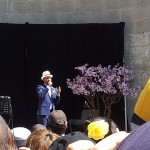
Japan Day @ Central Park celebrated its 8th year this past Sunday, and 50,000 attendees came out on this warm, beautiful day. As it coincided with Mother’s Day, many families enjoyed the events together. In addition to the free food and culture booths, an assortment of performances were featured on the main stage. There was some stellar taiko drumming and an interesting Matrix-like duo, but many in the crowd were waiting excitedly for the crooner Jero, who I wrote about and got to interview when he came to Japan Society two years ago.
This Pittsburgh native began his career singing enka (Japanese traditional ballads) as a youngster with his Japanese grandmother, and his official career started in Japan six years ago. Jero treated the audience to his debut single 海雪 (Umiyuki or Ocean Snow) as well as Read More
JQ Magazine: Concert Review—Yoshiki Classical World Tour Dazzles San Francisco with Surprise X Japan Guest
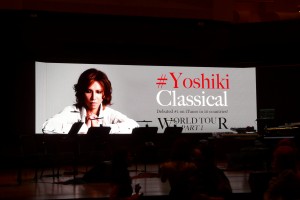
“The night offered something for everyone in Yoshiki’s ability to merge and bring together different genres and listeners and touch the collective beating heart therein.” (Shirong Gao)
By Shirong Gao (Shiga-ken, 2005-07) for JQ magazine. A member of JETAA Northern California, Shirong is a graphic designer, Illustrator, and breakfast food lover who worked in a Japanese countryside as seen only in Studio Ghibli movies. For more, visit gaoshirong.com.
Every night, as a child drifting off to sleep, I looped a rock ballad. My personal lullaby. A song by multi-million-selling heavy metal band X Japan, the Rising Sun’s answer to KISS. Yet not even in dreams did I see myself growing up to one day meet its leader, Yoshiki, and witness how far he’s come in his career.
A classically trained musician turned rock legend, Yoshiki has now returned to his more refined roots, embarking on a world tour of Yoshiki Classical concerts featuring music from the eponymous solo album released last year in collaboration with talents the likes of Beatles producer Sir George Martin and the London Philharmonic Orchestra.
On April 28, Davies Hall, home to the San Francisco Symphony, was packed on a Monday night to host only the second date of Yoshiki’s tour following its debut in Costa Mesa three days prior. “Definitely a different scene from a typical classical concert,” commented attendee Arisa Takahashi (Nara-ken CIR, 1991-92), who has also performed at the hall as part of the Sing Out, Davies! choral workshop. “There were people with blue hair, dressed in their frilly Lolita finery, sitting alongside classical music attendees.”
Justin’s Japan: Nippon in New York — Asa Akira, ‘Monkey Business,’ Jero @ Japan Day, Peelander-Z
By JQ magazine editor Justin Tedaldi (CIR Kobe-shi, 2001-02) for Examiner.com. Visit his Japanese culture page here for related stories.
As spring continues and the weather continues to warm, New Yorkers can enjoy activities all over the city both indoors and out.
May 2-3, 7:30 p.m.
Veggetti, Kato and Nakamura Project IX – Pleiades
Japan Society, 333 East 47th Street
$30, $24 Japan Society members
Two Japanese tour de force artists, acclaimed musician Kuniko Kato, praised by Steve Reich as a “first rate percussionist,” and dancer Megumi Nakamura, internationally known since her days with Jiří Kylián’s Netherlands Dance Theater, explore the mesmerizing scores of legendary 20th century composer Iannis Xenakis (1922-2001). Project IX – Pleiades, which features one of Xenakis’ most complex and ambitious pieces, Pléiades, is a multimedia work delivered through live performance and a state-of-the-art sound/projection installation. Directed by Italian choreographer Luca Veggetti, one of the featured artists in the 2014 NY PHIL BIENNIAL. The Friday, May 2 performance is followed by a MetLife Meet the Artists Reception.
Saturday, May 3, 2:00 p.m.
Monkey Business: Japan/America Writers’ Dialogue
Asia Society, 725 Park Avenue
$15, $12 seniors/students, $10 Asia Society and PEN members
In conjunction with PEN World Voice Festival 2014! For the past three years PEN World Voices and Asia Society have provided a place for dialogues between established and upcoming writers in the United States and Japan. This year Laird Hunt and Matthew Sharpe join Toh EnJoe and Hideo Furukawa for another exciting and provocative cross-cultural literary encounter between Japanese and American writers. Moderated by Motoyuki Shibata and Ted Goossen, editors/translators of Monkey Business, the English-language anthology of newly translated Japanese writing, now celebrating its fourth edition.Ticket price includes a copy of the book and signing following the program. For additional free readings taking place in Manhattan and Brooklyn, click here.
Tuesday, May 6
Insatiable: Porn—A Love Story by Asa Akira
$25 MSRP
At age 28, Asa Akira has already led an extremely unusual life. Born in New York and raised in Japan as a pre-teen, then coming of age at the prestigious United Nations International School in Manhattan, she eschewed the academic aspirations of her classmates and soon was earning a good living by stripping and working as a dominatrix at a sex dungeon. Akira has now built up a reputation for being one of the most popular, hardworking, and extreme actors in the adult entertainment industry, winning dozens of awards and appearing in nearly 400 films to date and the popular DVDASA podcast. In her debut book, Akira provides an inimitable voice from the inside in a world where porn is increasingly becoming part of the mainstream.
For the complete story, click here.
JQ Magazine: NY JET Alum Collaborates with Japanese Expats on ‘2nd Avenue’
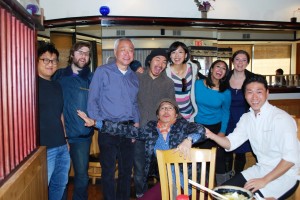
JET alum Tony Waldman (second from left) on the set of Web series 2nd Avenue. (Courtesy of Tsukasa Kondo)
By Julio Perez Jr. (Kyoto-shi, 2011-13) for JQ magazine. A bibliophile, writer, translator, and graduate from Columbia University, Julio is currently working at Ishikawa Prefecture’s New York office while seeking opportunities with publications in New York. Follow his enthusiasm for Japan, literature, and board gaming on his blog and Twitter @brittlejules.
She’s an aspiring actress with visa problems; he’s a gay law student and newly homeless. Can a fake marriage solve their problems? Mariko and Taichi are the stars of a goofy Web comedy filmed on location in New York called 2nd Avenue. You can tune into their zany adventures on YouTube and view the entire six-episode first season, which ended this past February.
The creative team behind 2nd Avenue includes Mari Kawade (director), Maho Honda (who plays Mariko), and Tsukasa Kondo (who plays Taichi). Kondo, who also is the writer for the series, was inspired by the many Web series online and decided to try writing something that would never be seen on Japanese TV, but would have a place on YouTube. He adds that his biggest inspirations for the story are “the actress Maho Honda, my life in New York as a gay man, and American TV shows.” Honda and Kawade also cite the diversity of New York City itself, and the stories of what people do just to survive in it, as a significant creative inspiration.
As you may have guessed, you can’t do something awesome involving Japan in New York without some JET alumni getting involved. Tony Waldman (Mie-ken, 2005-09) and his group New Beard provide the soundtrack for the show. The idea for this pairing took root after he met Kawade at the JET Alumni Association of New York’s annual Meishi Exchange event in 2013.
“She mentioned that she was looking for music for this Web series,” Waldman says. “We exchanged contact info and kept in touch. Many months later, she…asked if we could use my band New Beard’s music in the show. Us here in Beard Town (Williamsburg) gave her the OK, and our music became the soundtrack to the entire show…a true JETAANY Meishi Exchange success story!”
Justin’s Japan: Nippon in New York — Miyazaki, Godzilla, Tribeca Film Festival, Sakura Matsuri
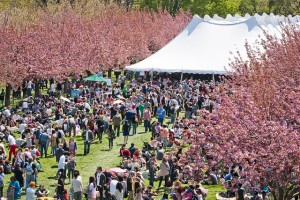
New York’s 33rd annual Sakura Matsuri will be held at Brooklyn Botanic Garden April 26-27. (Mike Ratliff)
By JQ magazine editor Justin Tedaldi (CIR Kobe-shi, 2001-02) for Examiner.com. Visit his Japanese culture page here for related stories.
Spring has sprung in the Big Apple, and that means one thing: a new season of sounds, colors, and spectacular performing arts to match the blossoming sakura trees throughout the city.
This month’s highlights include:
Tuesday, April 8
Turning Point: 1997-2008 by Hayao Miyazaki
MSRP $29.99, $34.99
The companion second volume to the earlier chronicleStarting Point: 1979-1996 (also new in paperback),Turning Point is an insightful collection of essays, interviews, memoirs, and illustrations from legendary animation director Hayao Miyazaki. The new title covers the critical stage in the legendary director’s career when his animated films for Studio Ghibli such as Princess Mononoke, Spirited Away, and Ponyo began to garner a significant international audience. Turning Point follows Miyazaki as his grand vision continued to mature, cinema-lovers worldwide discovered and embraced his creations, and prominent film critics such as Roger Ebert delivered tremendous acclaim for the director’s films. Bringing us up to the present is The Art of The Wind Rises, which captures the art of the film from conception to production, featuring in-depth interviews with the creative team from Miyazaki’s latest—and supposedly final—Academy Award-nominated epic.
April 8-13, 8:00 p.m. and 10:30 p.m.
Gary Burton & Makoto Ozone Duets
Blue Note Jazz Club, 131 West Third Street
$20, $35
Born in Kobe to a jazz organist father, Makoto Ozone came to Boston in 1980 to study at the Berklee College of Music, where multi-Grammy Award-winning vibraphonist Gary Burton was a composition and percussion instructor. After graduation he made his first American solo appearance in 1983 with a recital at Carnegie Hall. The incredibly talented young man struck a record deal with CBS, making his international debut in 1984 with the album OZONE. Burton and Ozone have been collaborators in the duet format for over two decades and recorded the Grammy-nominated Virtuosi in 2002. The versatile Ozone has hosted a TV series in Japan, ventured into electronics, and composed for and played with classical orchestras in addition to working with his own jazz trio from his home in New York.
Wednesday, April 9, 8:00 p.m.
Carnegie Hall, 881 Seventh Avenue
$22.50-$140
Praised by the New York Times when she last appeared at Carnegie Hall as “among the most respected artists of our time” for her “probing and magisterial performances” of Schubert’s last three sonatas, pianist Mitsuko Uchida returns to perform his “Reliquie” Sonata, once mistakenly thought to be the composer’s final work. Also on the program is Beethoven’s all-encompassing and transcendent Thirty-Three Variations on a Waltz by Diabelli.
For the complete story, click here.
Justin’s Japan: Nippon in New York—Japan Week at Grand Central, Mayday debut, Jake Shimabukuro
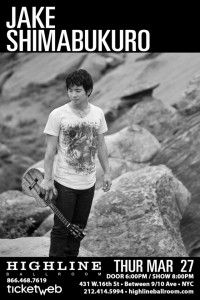
Ukulele hero Jake Shimabukuro returns to Highline Ballroom March 27. (Courtesy of Highline Ballroom)
By JQ magazine editor Justin Tedaldi (CIR Kobe-shi, 2001-02) for Examiner.com. Visit his Japanese culture page here for related stories.
Tucked between Oscar and cherry blossom season, March offers an unmissable array of concerts, performances and exhibitions, along with a special gathering to mark the three-year anniversary of the Tohoku earthquake and tsunami.
This month’s highlights include:
March 1-2, 2:00 p.m.
Kaleidoscoping Tohoku: Three Years After the Disaster in 2011
J-LABO Brooklyn, 300-302 Seventh Street, Park Slope
Free
Three years have now passed since the tsunami, earthquake and nuclear accident in 2011 rocked Eastern Japan, yet those who have visited since have been enchanted by the rich culture and history of Tohoku, forging relationships with local residents across generations and geographies. Now, various new projects, art works, crafts, and business from the traditional and the contemporary have emerged. Contents of the two-day event include regional progress reports; a silent auction and charity sale; an exhibition featuring a display of local crafts and a documentary film of Fukushima residents; and of course, food and sake!
Monday, March 2, 11:00 a.m./2:00 p.m./4:30 p.m.
Engleman Recital Hall at Baruch Performing Arts Center, 55 Lexington Avenue
$25 advance/$31 day of event at box office
A show for all ages, this celebration of otaku culture displays how total devotion to one’s artistry creates a truly unique and unforgettable performance. With 15 years of experience, Syan is considered one of the top balloon artists of Japan, becoming the first person ever to win the triple crown of Japanese balloon competition the year he turned pro. A graduate of Japan’s only circus school, Saito is an accomplished juggler, acrobat, balloon twister, and award winner best known for his ninja performance, where he showcases his artistry while clad in black.
March 6-8
Vanderbilt Hall at Grand Central Terminal, 89 East 42nd Street
Free
Japan Week’s annual program highlights unique features of Japanese culture from the last 100 years to the present. Delectable regional foods, technology exhibits, and traditional arts and performances will aim to inspire greater understanding of Japan and travel to the country. There’s something for everyone, from the fresh aroma of Kyoto green tea; a new NTT DOCOMO smartphone app that translates spoken Japanese and English; an introduction to Japanese artistry including hand-blown glass house wares, wooden keyboards and USB’s, gold lacquered iPhone cases; and more. Those planning an international trip can head to the Visit Japan booth for in-person info about travel and various regions.
For the complete story, click here.
Justin’s Japan: Nippon in New York — ‘Dragon Ball’ in Color, Lolita Fashions, ONE OK ROCK’s Debut
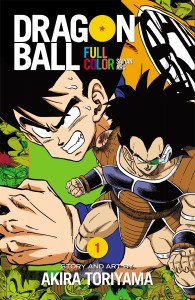
Dragon Ball Full Color makes its English-language debut in print and digital Feb. 4. (VIZ Media LLC)
By JQ magazine editor Justin Tedaldi (CIR Kobe-shi, 2001-02) for Examiner.com. Visit his Japanese culture page here for related stories.
Stay warm this winter with some hot local events, from the debut performance of one of Japan’s most successful live acts, another performance from one of the country’s biggest crossover stars, and an annual showcase that brings the sights (and tastes) of Japan to vivid life.
This month’s highlights include:
Saturday, Feb. 1, 6:00 p.m.
Asia Society, 725 Park Avenue
Free
The final entry of the film series Vengeance Is Shohei Imamura! Yasuko was exposed to black rain, the radioactive fallout from the atomic bomb dropped on Hiroshima. Years later, she and her townsmen continue to rebuild their life and endure the aftermath. At an age ripe for marriage, Yosuko has been rejected by man after man for fear of radiation, even though she has shown no signs of any illness. The film juxtaposes present-day struggles with flashbacks to scenes of wartime devastation. A departure from Imamura’s usual interest in bawdy human behavior, this film brings him closer to his early mentor Ozu, who is known for his restrained and subdued study of quiet dignity and for whom Imamura acted as assistant director.
Tuesday, Feb. 4
Dragon Ball Full Color, Volume 1
$19.99 MSRP
Akira Toriyama’s epic manga series—one of the most popular of all time—makes its English-langage debut in full color, graphic novel-size in print and digital editions! Son Goku is the greatest hero on Earth. Five years after defeating the demon king Piccolo, he’s grown up and has a family. But what is the real reason for Goku’s incredible strength? A visitor from outer space arrives bearing terrible news—Goku is an alien, and the visitor, Raditz, is Goku’s brother! When Raditz turns out to be a ruthless killer, Goku must fight his incredibly strong brother to save his family and the entire human race. A surprising alliance may be Earth’s last hope: Goku will team up with his old enemy Piccolo to save the world!
Tuesday, Feb. 4, 7:30 p.m.
Joe’s Pub, 425 Lafayette Street
$30 reserved, $35 premium
Akiko Yano returns to Joe’s Pub with her longtime New York friends/virtuoso musicians Will Lee and Chris Parker, answering overwhelming demand from the fans who caught their previous go-round in November 2012. See the pop and jazz chanteuse whom Jon Pareles of the New York Times calls “a world class songwriter with a clear, gentle, wide-ranging voice. She is also an accomplished, endearing performer who might be a Japanese Carole King, Joni Mitchell or Meredeith Monk…”
For the complete story, click here.
JQ Magazine: The Steady Riser – A Conversation with Tokyo Musician Nelson Babin-Coy

“The Japanese market is a very unique market; it’s very closed. It is kind of frustrating when I try to introduce Western ideals in my music or introduce how I feel live music should be enjoyed at gigs or live venues. If you want to dance, dance. If you want to move, move.” (Lisa (paint with stars) www.paintwithstars.com)
By Sheila Burt (Toyama-ken, 20010-12) for JQ magazine. Sheila recently returned to America after living in Japan for three years (two years in Namerikawa with JET and one year at a private school in Ehime-ken). She is currently looking for a job and welcomes all leads. View more of her work at www.sheilaburt.com.
The first time Tokyo-based musician Nelson Babin-Coy visited Japan, he was a 15-year-old high school student from the suburbs of L.A. who knew next to nothing about Japan. Interested in learning more about Japanese music during his stay in Gunma Prefecture, he started listening to what other teenagers his age were into, including the idol group Morning Musume. Yet when he first heard one of the band’s songs, he cringed a bit. “I wasn’t disgusted, but I was like, ‘This is music in Japan?’,” he laughs.
Thankfully, his host sister introduced him to the Battle Royale theme song by Dragon Ash, and he was hooked. The two weeks Babin-Coy spent in Gunma were enough to give him a new dream to follow. He wanted to live in Japan, though he had yet to figure out the how and what to do.
“I love Japanese music and lyrics,” he says. “I think Japanese artists are more artistic in the way they form their stories.”
Now 28, Babin-Coy is a rising singer-songwriter who primarily sings in Japanese and works with several native artists trying to break into the Western market. He has toured the mainland three times with his band, nothing ever lasts (currently on hiatus).
Justin’s Japan: Nippon in New York—Yayoi Kusama, Taka Kigawa, Taro Hakase, VAMPS
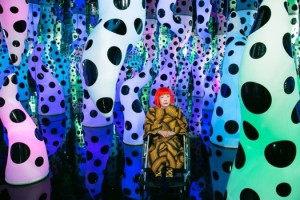
Yayoi Kusama with Love Is Calling (2013) installed as part of the artist’s inaugural exhibition I Who Have Arrived in Heaven at David Zwirner Gallery, on view through Dec. 21. (Will Ragozzino)
By JQ magazine editor Justin Tedaldi (CIR Kobe-shi, 2001-02) for Examiner.com. Visit his Japanese culture page here for related stories.
With Thanksgiving weekend (and the hopes of eating right) now just a memory, we turn to colder weather, falling snow, and the new year to come. Fortunately for Japanese culture fans, December is just as busy as the holiday season itself. Whether you’re hosting guests from out of town or looking to squeeze in an event or two in between parties, we’ve got you covered.
This month’s highlights include:
Now through Saturday, Dec. 21
Yayoi Kusama: I Who Have Arrived in Heaven
David Zwirner Gallery, 525 West 19th Street
Free
In case you missed last year’s retrospectiveat the Whitney featuring the artist’s mega-buzzed about Fireflies on the Water, this current exhibition by Yayoi Kusama features 27 new large-scale paintings and The Souls of Millions of Light Years Away, a new mirrored infinity room made especially for this exhibition and the United States debut of another infinity room, which was recently on view in Tokyo at the Mori Art Museum. Also exhibited is the artist’s video installation, entitled Manhattan Suicide Addict, that draws its title from her first semi-autobiographical novel published in 1978.
Wednesday, Dec. 4, 8:00 p.m.
Three’s Keys feat. Taka Kigawa
Klavierhaus Recital Hall, 211 West 58th Street
$15
As part of its third annual festival entitled Timbre Tantrum, Composers Concordance(“Enterprising new music organization” –New York Times) presents this all-piano production featuring Taka Kigawa (“Extraordinary pianist” –New York Times), Inna Faliks (“Signature blend of grace and raw power” –Lucid Culture) and Carlton Holmes (“Inventive” –Jazziz). Each pianist will present a 20-minute solo set of their own contemporary repertoire, including music by Shchedrin, Zhurbin, Ellington, Palkowski, Monk, and Alexander. The grand finale serves up a triple-piano suite composed by Dan Cooper, Sean Hickey, Debra Kaye, Milica Paranosic, and Gene Pritsker performed on Klavierhaus’ antique instruments, including a 19th century Pleyel.The concert will be followed by a brief reception.
Thursday, Dec. 5, 8:00 p.m.
Town Hall, 123 West 43rd Street
$49.50-$89.50
A violinist since the age of four, contemporary classical and crossover musician Taro Hakase returns to New York as part of his first-ever world tour. Entitled JAPONISM after his latest album, Hakase’s pop-infused compositions and charismatic showmanship are known to get fans dancing at his concerts. First brought to international attention following a collaboration soundtrack and a concert tour with Celine Dion in 1996, Hakase has performed before over two million people and has sold more than six million albums in Japan alone. Along with his eight piece band, Hakase brings his tour to one of New York’s most celebrated stages.
For the complete story, click here.
JQ Magazine: JQ&A with Producer Jeron Moore on ‘The Legend of Zelda: Symphony of the Goddesses’
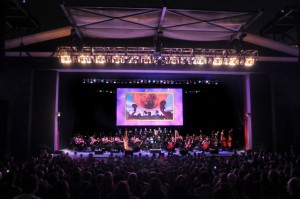
Producer Jeron Moore on Symphony of the Goddesses: “We cater to all ages. You’ve got to remember that Zelda is 27 years old now. We’re seeing fans spanning three generations buying tickets to the show.” (Andrew Craig)
By Vlad Baranenko (Saitama-ken, 2000-02) for JQ magazine. Vlad is an avid photographer.
F. Scott Fitzgerald famously said, “There are no second acts in American lives.”
Fortunately, there are Second Quests.
Over 25 years after the blockbuster Nintendo video game series first hit the scene bearing its namesake in honor of Fitzgerald’s wife, The Legend of Zelda: Symphony of the Goddesses returns for an encore run in some of North America’s most distinguished theater halls (including, for the first time, a pair of dates in Mexico). Presented by Jason Michael Paul Productions, the show—currently on tour through December—presents the very best of Zelda’s lush symphonic scores paired with a live orchestra and visual effects.
In this JQ exclusive, producer and lead creative Jeron Moore sounds off what’s new about the show, the experience of working with Nintendo to bring the ultimate live experience to fans, and the evolution of Link throughout the saga’s rich history.
What was the inspiration for this installment of the show?
Well, if you’re a Zelda aficionado, you’ll recognize the term “Second Quest” from the New Game+ mode from the original 1986 entry, The Legend of Zelda, on the NES. It’s a mode you’d unlock once you defeated the game, and what it did was reorganize the game a little bit, made the dungeons a bit harder, made the items a bit more challenging to find, made the bosses a bit more difficult to defeat. We’ve taken the idea of visiting familiar places while encountering new challenges and applied that to the Second Quest, which has been revamped to include a half hour of new material while keeping all of the classics that make The Legend of Zelda what it is.
What surprises can we expect from the Second Quest?
They wouldn’t be surprises if I told you! But I will hint that we’re celebrating the 20th anniversary of a particular, very special handheld title. We’ve also finally included some music from one of the most recent Zelda games, which we steered cleared of with the first season program. And at the request of Mr. Eiji Aonuma, you can also expect to see a fully revamped Wind Waker segment, featuring gorgeous visuals from the game’s recent HD release on the Wii U. The Wind Waker has never looked better.
How did the idea for format of the show come about? The large screen, the orchestra?
It’s simple. There’s just nothing classier than a large orchestra tuning up, then performing powerhouse symphonic interpretations of your favorite music, no matter the genre. For The Legend of Zelda, we wanted Symphony of the Goddesses to be as accessible as possible. There’s nothing worse than sitting in a room and feeling left behind because you didn’t walk in with a prerequisite knowledge of the material. The music undoubtedly stands on its own, but incorporating visuals opens it up and informs the entire audience of context, not just those who’ve played the games before. Of course, being the fans that we are, we’ve carefully edited the footage into an entertaining narrative that, we feel, makes sense. With that, we’re able to hit on many of the important moments universally adored by fans, so yeah—lots of inside jokes, but we try not to let anything fall flat.
JQ Magazine – Book Review: ‘The Way of Taiko’
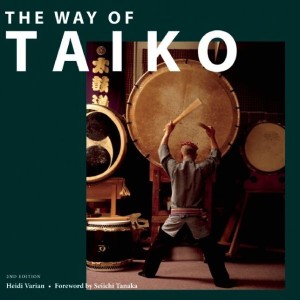
“Those who want to learn more about taiko, whether they are novices in Japanese drumming or have been playing for several years, will be amazed by the rich history and culture of the genre.” (Stone Bridge Press)
By Rashaad Jorden (Yamagata-ken, 2008-10) for JQ magazine. A former head of the JETAA Philadelphia Sub-Chapter, Rashaad currently studies responsible tourism management at Leeds Metropolitan University. For more on his life in the UK and enthusiasm for taiko drumming, visit his blog at www.gettingpounded.wordpress.com.
Many JETs—myself included—have been drawn to taiko because we love the sound emanating from the drums and want to partake in something traditionally Japanese. But what do we really know about taiko?
For those looking to expand their knowledge of Japanese drumming, Heidi Varian’s The Way of Taiko (now available in a new edition from Stone Bridge Press) is a great way to go. Varian, a member of the San Francisco Taiko Dojo, introduces readers to the history and contemporary culture of the music that is a symbol of Japan to many.
Varian calls taiko the “heartbeat of Japan,” and that’s appropriate because the drum was a method of gathering townspeople or letting them know about any impending danger, in addition to being used to celebrate festivals. Like seemingly everything that’s considered an integral part of Japan, taiko has an enormously long history clouded in mystery (it actually may not have originated in Japan), but Varian explores it.
She not only examines taiko’s beginning and its importance in ancient Japan, but how taiko appeared in traditional Japanese theatrical forms like noh and kabuki. She also writes about how taiko gained a foothold in the United States—the first documented taiko drum appeared in San Francisco in 1910—and its pioneers (such as Seiichi Tanaka and Kenny Endo) on this side of the Pacific. Varian also doesn’t also live in the past when talking about taiko, as she raises important issues about its future.
Justin’s Japan: Nippon in New York – Heritage at Citi Field, Hatsune Miku and the Joy of Sake
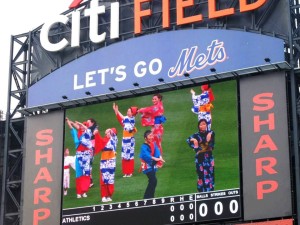
The Japanese Folk Dance Institute of New York will perform at Citi Field’s fourth annual Japanese Heritage Night Aug. 28. (Courtesy of blog.janm.org)
By JQ magazine editor Justin Tedaldi (CIR Kobe-shi, 2001-02) for Examiner.com. Visit his Japanese culture page here for related stories.
As the summer winds fade to fall colors, the weeks ahead are shaping up with these exciting events, ready to be enjoyed both before and after Labor Day.
This month’s highlights include:
Wednesday, Aug. 28, 6:30 p.m.
New York Mets Fourth Annual Japanese Heritage Night
Citi Field, 123-01 Roosevelt Ave.
$23 Promenade Reserved/$37 Pepsi Porch/$63 Baseline Box Silver
Watch the Mets take on the Philadelphia Phillies with a special Japanese Heritage Night pre-game show featuring the Japanese Folk Dance Institute of New York, the Japanese Men’s Choir, taiko and fue master Kaoru Watanabe, and the Spirit Award presentations to important members of the community. Look for fun Japanese activities and games throughout the evening at the special Japanese Heritage Night tables! A portion of the proceeds of all ticket sales made through the special JHN ticket window and through online sales will be given to the Japanese American Association’s Committee on Aging Issues.
Saturday, Aug. 31, 2:00 p.m.
Hatsune Miku Magical Mirai 2013 premiere
Anthology Film Archives, 32 Second Avenue
$20 general admission
In Japan, Hatsune Miku is a phenomenally successful virtual idol that grew out of fan-created songs. With a name meaning “first sound of the future,” she is based on an innovative singing synthesizer software character. This special theatrical release—her first in the U.S. in nearly two years—celebrates the pop Vocaloid’s sixth birthday of by capturing a special commemorative live concert at the Yokohama Area simulcast in both New York and Los Angeles. (For this Examiner’s review of Miku’s previous live film screening in Times Square, click here.)
Sunday, Sept. 1, 5:30 p.m.
J-Summit New York Benefit Concert
The Bowery Electric, 327 Bowery
$15 advance/$18 day of show
Offering a welcoming environment to enjoy music, dance, performance and fashion for all fans and artists, j-Summit New York has created a community focused on the connections and cultural exchanges between New York and Japan through electrifying events. Proceeds for this special benefit concert will contribute to the 2011 earthquake and tsunami relief fund. Bands for the night include Aki, Lust, Red, Iri, Nicole Oliva, Nafsi Groove, and Yuri Bear.
For the complete story, click here.
Justin’s Japan: Nippon in New York — Karaoke Networking, Poisson Piano and ‘Cutie and the Boxer’
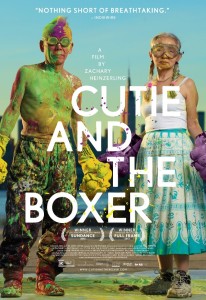
The award-winning documentary Cutie and the Boxer premieres at Lincoln Plaza Cinema and Landmark Sunshine Cinema Aug. 16. (RADiUS-TWC)
By JQ magazine editor Justin Tedaldi (CIR Kobe-shi, 2001-02) for Examiner.com. Visit his Japanese culture page here for related stories.
In the dog days of summer, it’s best to escape the heat in a place that’s cozy and cool. For those into Japanese cultural events, this month offers a diverse selection of music, film premieres and parties—all in the comfort of indoor air conditioning.
This month’s highlights include:
Thursday, Aug. 1, 7:30 p.m.
Young Professionals 2nd Annual Midsummer Matsuri and Karaoke Party
Japan Society, 333 East 47th Street
$10 for corporate and individual members, $15 for non-members
Japan Society’s Young Professionals events provide the opportunity for emerging business leaders from the U.S. and Japan (aged 25-45) to meet people with similar interests, experience programming on timely topics, and network with their peers. Attendees are invited to join for a night of networking, singing, eating and drinking featuring singer and Japanese TV personality Alex York as MC! Yukata and other summer attire are welcome, and admission includes light Japanese food and one drink ticket, cash bar thereafter. Space is limited; for advance registration email youngpro@japansociety.org or call 212-715-1219.
Saturday, Aug. 3, 7:00 p.m.
Asia Society, 725 Park Avenue
$35 members/students/seniors, $40 nonmembers
As part of the closing night presentation of the 36th Asian American International Film Festival, this screening of Our Homeland includes a Q&A with the director followed by an awards ceremony and gala reception featuring chef’s tasting tables and open bar with specialty cocktails sponsored by Rémy Martin. Sent decades ago as a child to North Korea under a repatriation program, Sungho returns to Japan for a temporary medical visit. A wrenching human drama unfolds as his family grapples with why he was ever let go. Under the constant surveillance by an accompanying North Korean official, Sungho and his family reunite again in this sensitive tale inspired by Korean-Japanese director Yang Yonghi’s true family story. Capturing the tender feelings of separation, memory, and belonging, the film also provides a rare glimpse into the life of ethnic Koreans in Japan. Presented in Japanese and Korean with English subtitles.
Friday, Aug. 16
Lincoln Plaza Cinema and Landmark Sunshine Cinema
$13, $13.50
Winner of the Directing Award for U.S. Documentary at the 2013 Sundance Film Festival and a hit at film festivals around the world, this candid New York story explores the chaotic 40-year marriage of renowned “boxing” painter Ushio Shinohara and his artist wife, Noriko. As a rowdy, confrontational young artist in Tokyo, Ushio seemed destined for fame, but met with little commercial success after he moved to New York City in 1969, seeking international recognition. When 19-year-old Noriko moved to New York to study art, she fell in love with Ushio—abandoning her education to become the wife and assistant to an unruly, husband. Over the course of their marriage, the roles have shifted. Now 80, Ushio struggles to establish his artistic legacy, while Noriko is at last being recognized for her own art—a series of drawings entitled “Cutie,” depicting her challenging past with Ushio. Spanning four decades, the film is a moving portrait of a couple wrestling with the eternal themes of sacrifice, disappointment and aging, against a background of lives dedicated to art.
For the complete story, click here.

